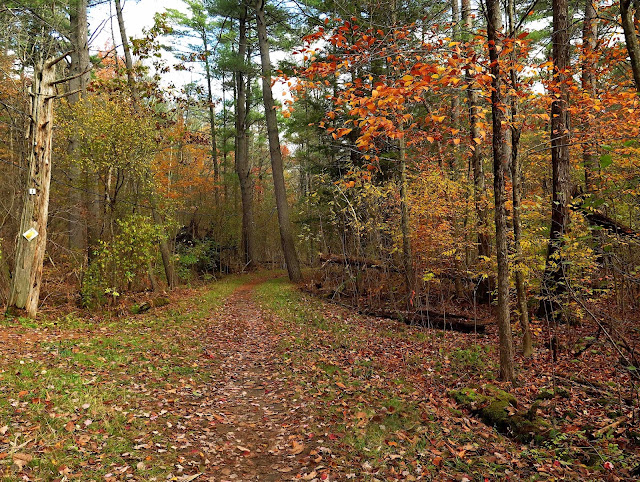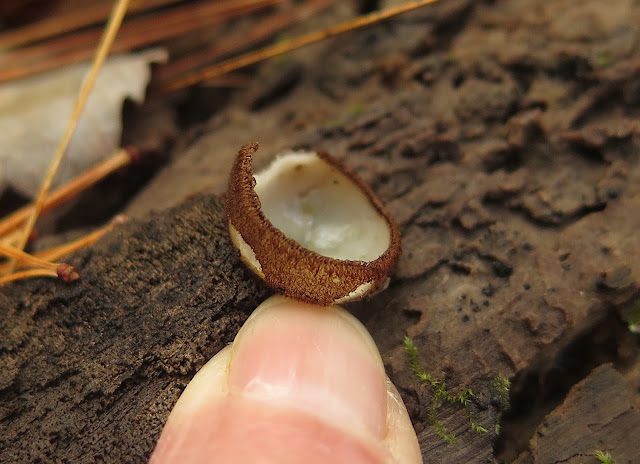Although the tree leaves this year are not nearly so brilliant as they have been in years past, the Winterberry shrubs (Ilex verticillata) are having a very fruitful year, the twigs heavy with bright-red berries.
Despite the distractions of those two beautiful fruit-bearing shrubs, I spent my most fascinated time in Cole's Woods exploring the barkless wood of this rotting tree trunk. I realize it doesn't draw much attention to itself at first glance, but let's just take a closer look.
The first thing I noticed about this old log were masses of these tiny orange disks, each disk rimmed with a fringe of minute black hairs. I believe this fungus is a smaller version of the Eyelash Cup Fungus, this mini-version called by the scientific name Scutellinia setosa. There were hundreds and hundreds of them scattered across the damp de-barked wood of this fallen trunk.
Here was another cup fungus on this same log, still small but quite a bit bigger than those orange mini-disks, and this one with a brown hairy coating surrounding a pearly-white glossy interior. It has the descriptive vernacular name of Hairy Fairy Cup. Humaria hemisphaerica is its scientific name.
Yet another small fungus populated this same log, this one a ruddy species called Copper Penny (Pachyella clypeata).
All three of these aforementioned fungi are "sac" fungi, so called because their sexual spores are produced in sac-like mother cells. The key feature of these cup-shaped sac fungi is that the extremely tiny spore sacs are produced in a layer over the upper surface of the fruitbodies, sometimes as many as hundreds of millions of them covering the surface of a single fruitbody. When ripe, the sacs explode to discharge the spores violently into the air. The spores are so tiny that they are virtually invisible, but when millions of sacs fire simultaneously, the spores appear like smoke above the fruitbodies. I have never seen this phenomenon, but I will be looking for it among these fall-fruiting sac fungi.
This next fungus is probably one of the most common of the sac fungi. Called Lemon Drops (Bisporella citrina), they also are found on damp rotting logs, and they commonly fruit in great numbers, often by the hundreds, ranging in size from pin-head-sized dots to dime-sized disks. I usually find them more spread out than this crowded cluster is. They are so brightly colored, they are hard to miss, even when very tiny, and they often persist late into the fall.
Here's one more fall-fruiting fungus often found on rotting logs, this one a jelly fungus called Fan-shaped Orange Jelly (Dacryopinax spathularia). This bright-colored glossy fungus is often found fruiting in dense rows along cracks in the debarked wood, which was how I found it fruiting this day.
Another organism to join the fungi on this rotting log was a liverwort called Variable-leaved Crestwort (Lophocolea heterophylla). Often mistaken for a moss, this evergreen liverwort develops a low mat of sprawling leafy shoots, with two-toothed individual leaves arranged opposite from each other on the stems. I thought this was an especially pretty clump of it joining the fungi on my log.
As Sue and I wandered the wooded trails, we enjoyed identifying the fading remnants of summer-flowering plants like Shinleaf, Frostweed, and Green Rockcress (a rare one!). But here was a genuine surprise: a solitary bloom of Dog Violet (Viola labradorica), blooming again, long after it had gone to seed.













2 comments:
This is a nice "preview" of our upcoming walk in these wonderful woods.
Ah fungi -- so hard to tell those tiny ones apart !
iNat agrees on the Scutellinia setosa for the smaller yellower Eyelash Cups,
but in looking at their photos of choices for the gelatinous yellow fungus we saw, it comes closer to Dacrymyces chrysospermus (Orange Jelly Spot). Not as pronounced a "stem" on what we saw.
Also check out their photos of Ascocoryne cylichnium (a relative of Purple Jelly Fungus) as an alternative for the Copper Penny (Pachyella clypeata) -- they look so much alike, though --quite a bit of overlap !
But there are more photos there than my mushroom book to compare against, plus maps.
Sometimes I put up an observation with my guess and wait for comments to come in, that in itself is a learning experience!
I love all those tinyfungi. Amazing what you found on that fallen log!
Post a Comment